By Laurie Chong with contributions by Raphael Moral, Jinghua Guo, Tom Russell, and Shannon Ciston
The Foundry held its 2025 Annual User Meeting on August 13-15, featuring an impressive lineup of presentations that spanned from quantum computing scalability to asteroid sample analysis, highlighting the facility’s role as a nexus for cutting-edge nanoscience research.
Automating the Future: AI and Automation Summer School
Prior to the main meeting, the Molecular Foundry hosted a comprehensive AI and Automation Summer School, addressing the growing integration of artificial intelligence and machine learning in materials science research. Participants did not need prior coding experience and learned to utilize ChatGPT-assisted coding which makes advanced computational techniques accessible to a broader research community.
The summer school welcomed participants from diverse institutions and career stages, totaling 29 attendees. They engaged in hands-on activities across all phases of closed-loop experimentation; from sample preparation and characterization to data processing and machine learning modeling. Attendees were divided into four groups, each assigned a distinct activity. One group prepared thin films manually in one lab, while another fabricated identical films using a robotic arm (Autobot) in another. Simultaneously, a third group processed previously collected data and trained machine learning models to extract key insights from thin films with applications in photovoltaic cells. Meanwhile, the fourth group attended a demonstration of the atomic layer deposition bot (ALDbot). The central takeaway of the school was to highlight how automated synthesis, combined with machine learning, can accelerate materials optimization and discovery, while minimizing human error throughout the process.
Quantum Computing Takes Center Stage
The Thursday session opened with a keynote address by John Martinis from UC Santa Barbara, who outlined the ambitious path toward scaling quantum computers from hundreds to millions of superconducting qubits. Martinis presented a brief historical development of quantum qubits, with a focus on the developing research pathway and the importance and relevance of whether materials for quantum qubits can be scaled up using the industrial semiconducting manufacturing technology, and reported the protection of classical states from environmental bit-flip errors and demonstrate the suppression of these errors with increasing system size.
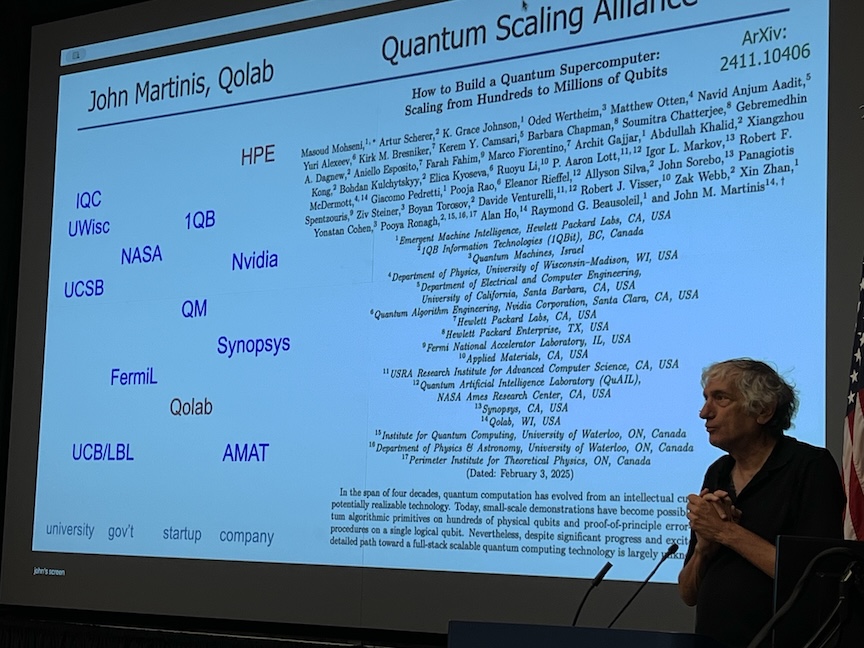
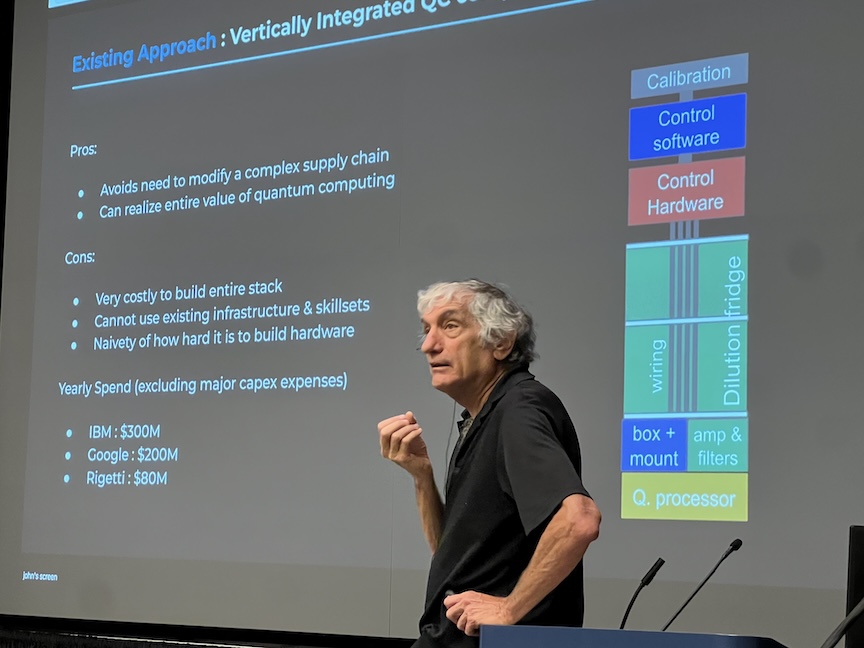
He emphasized that while small-scale demonstrations on hundreds of physical qubits are now possible, significant challenges remain in quantum hardware, fabrication, software architecture, and algorithmic development. His presentation highlighted how existing semiconductor technology could be adapted to build higher-quality qubits while employing system engineering approaches for scalable quantum computing.
Harnessing F-Elements for Nuclear Safety and Medicine
Friday’s plenary session featured Rebecca Abergel from UC Berkeley and Berkeley Lab, who delivered a compelling keynote on the critical role of f-elements in addressing some of society’s most pressing challenges. Abergel’s presentation, “Molecular recognition and differentiation of f-elements to harness their unique properties,” explored how lanthanides and actinides are becoming increasingly vital across diverse applications—from nuclear power generation and clean energy technologies to advanced catalysis and precision medicine.
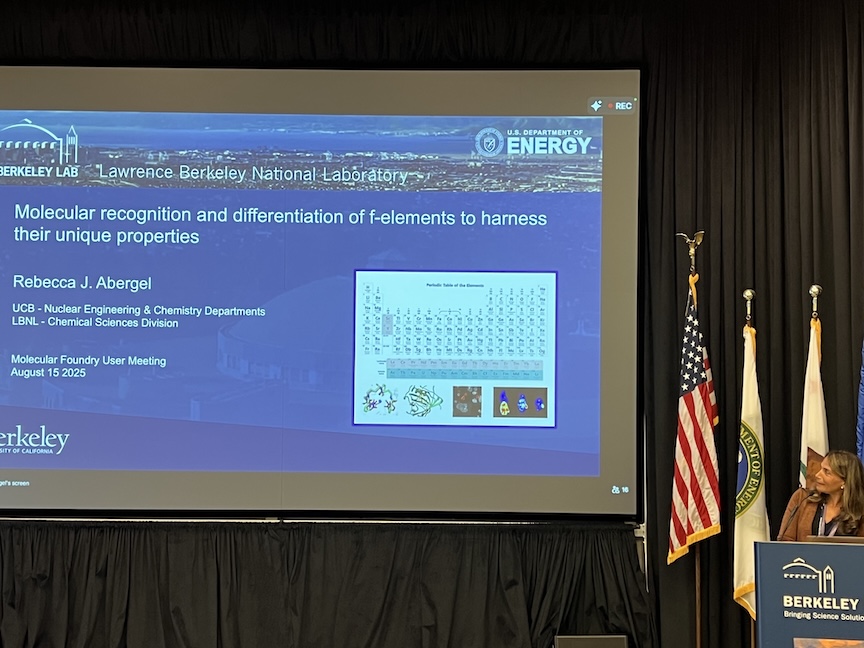

Abergel emphasized the dual nature of f-element chemistry: while these elements offer tremendous potential for beneficial applications, they also present significant challenges related to nuclear accident contamination, environmental impact from rare earth mining, and the need for precise control in radioisotope-based cancer therapies. Her research addresses these challenges through innovative molecular recognition approaches that achieve unprecedented coordination control using high-affinity, bio-inspired chelating ligands.
The presentation highlighted how multidisciplinary collaboration—combining advanced characterization techniques with data mining and creative chemistry—enables the development of highly efficient separation reagents and novel therapeutic agents. By leveraging the unique properties of each f-element and drawing on diverse scientific backgrounds, Abergel’s team is pioneering technologies that could transform nuclear remediation, sustainable mining practices, and targeted cancer treatment, demonstrating how fundamental coordination chemistry research can directly benefit society.
Highlights from Across Materials Science
Throughout the plenary sessions, attendees heard from several Foundry users about their recent work, demonstrating the breadth of research enabled by the Molecular Foundry’s capabilities:
Halide Perovskite Innovations: Shaun Tan from MIT discussed in situ characterization techniques for halide perovskite materials, revealing how these materials undergo rapid crystallization and dynamic transformations during formation. His work demonstrated how in situ photoluminescence spectroscopy could detect surface vacancy defects and revealed slow halide homogenization processes that fundamentally alter crystallization pathways.
Asteroid Sample Analysis: Zack Gainsforth from UC Berkeley shared findings from NASA’s OSIRIS-REx mission samples. Using transmission electron microscopy at the Molecular Foundry and X-ray absorption spectroscopy at the Advanced Light Source, researchers analyzed 121.6 grams of material from asteroid Bennu. The analysis revealed molecular carbonates deposited throughout the asteroid from water evaporation and remarkable organic signatures providing clues about primordial organics from the early solar system.
Advanced Electrolyte Understanding: Tod Pascal from UC San Diego presented work on exploring local microstructure in complex electrolytes using enhanced sampling molecular simulations. His team’s computational workflow, developed in collaboration with Foundry scientists, successfully predicted solubility limits in aqueous LiCl solutions that closely aligned with experimental results across temperature ranges of 283–313 K.
Bacterial Microcompartment Engineering: Kyleigh Range from Michigan State University and Berkeley Lab presented her work on bacterial microcompartments (BMCs)—proteinaceous organelles that naturally enhance catalytic pathways by encapsulating enzymatic cargo within selectively permeable shells. Range has worked to develop an innovative in vitro assembly method using urea as a chaotropic agent to control BMC shell construction, overcoming significant limitations of traditional in vivo expression methods. This approach enables large-scale production of BMC shells and allows encapsulation of both biological and non-biological cargo under diverse reaction conditions, dramatically expanding the design possibilities for engineering specialized catalytic systems with enhanced properties.
The meeting also showcased new and upcoming Foundry capabilities presented by staff scientists Stephanie Ribet, Peter Denes, and Shaul Aloni, demonstrating the facility’s continued evolution in providing state-of-the-art instrumentation and expertise to the user community.
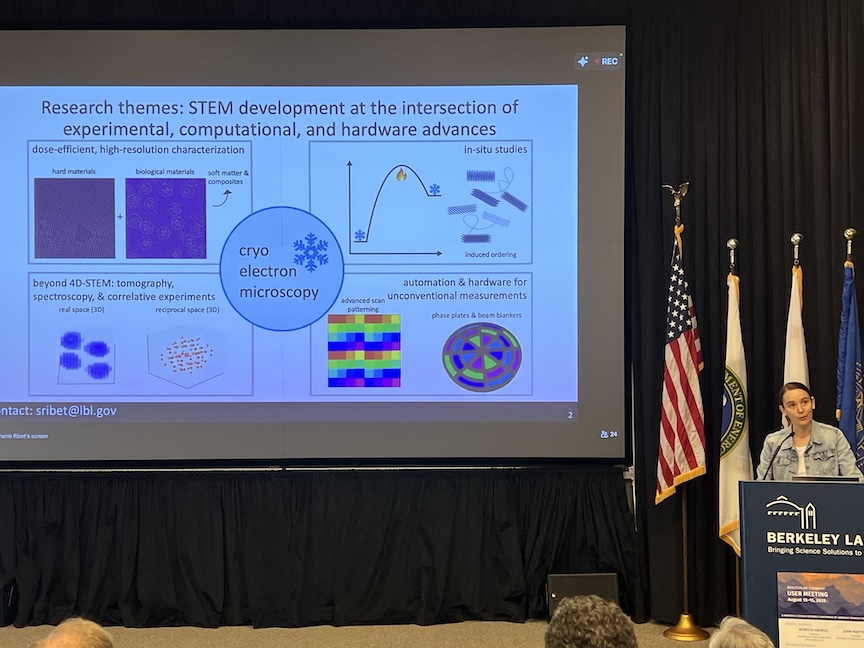
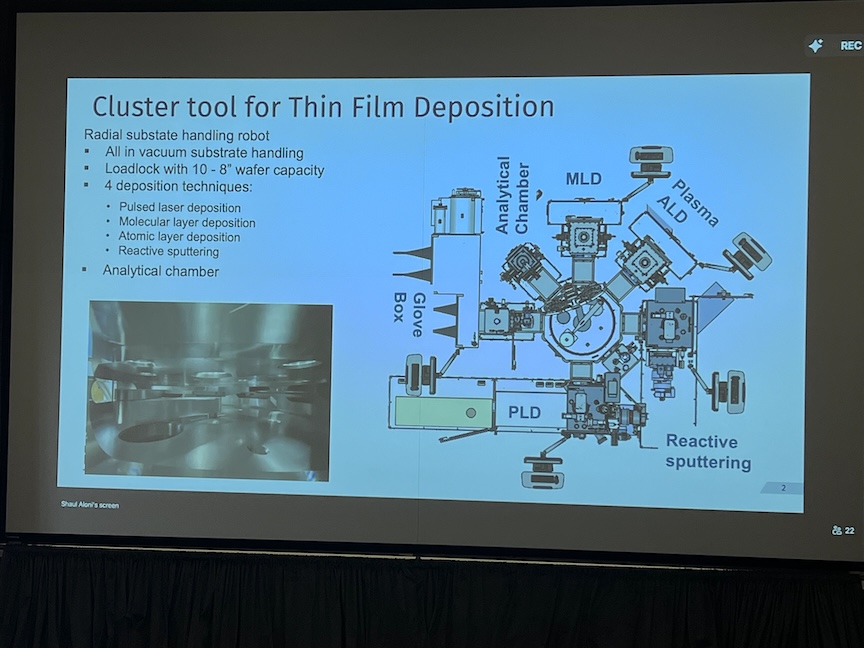
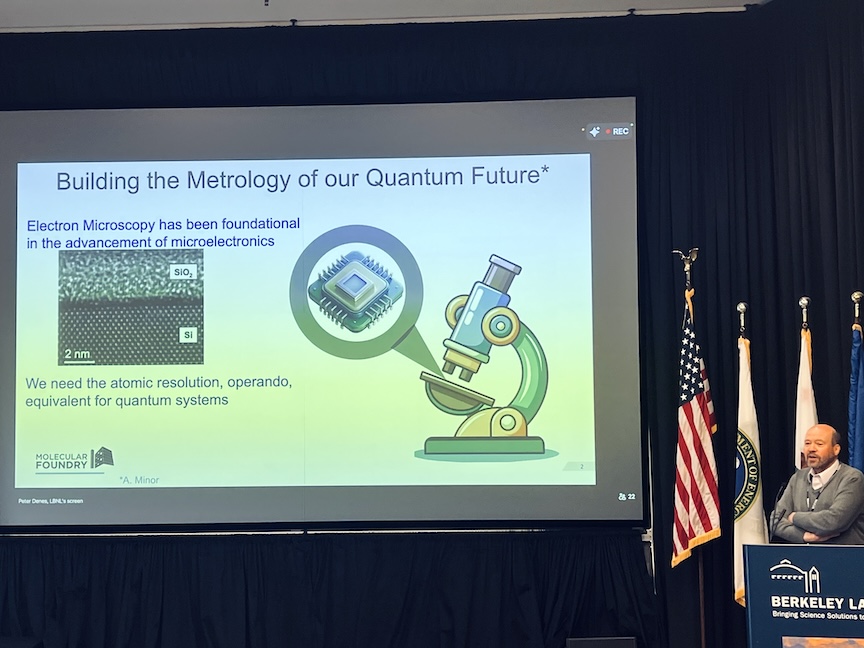
2025 Awards
The meeting recognized outstanding contributions with paper awards:
Postdoc Paper Award Winner: Min Gee Cho from Berkeley Lab presented a data-driven statistical analysis of shape evolution in inorganic nanocrystals. Her high-throughput pipeline integrated deep learning-based segmentation with quantitative shape analysis, processing 727 transmission electron microscopy images to analyze 441,067 Co₃O₄ nanoparticles and identify critical shape transition thresholds.
Student Paper Award Winner: Eliza Neidhart from the University of North Carolina at Chapel Hill showcased work on polyolefin C–H functionalization to create reprocessable thermosets. This collaboration between UNC and the Molecular Foundry demonstrated how polyolefin waste could be converted into reprocessable materials with enhanced mechanical properties, contributing to circular plastics economy development.
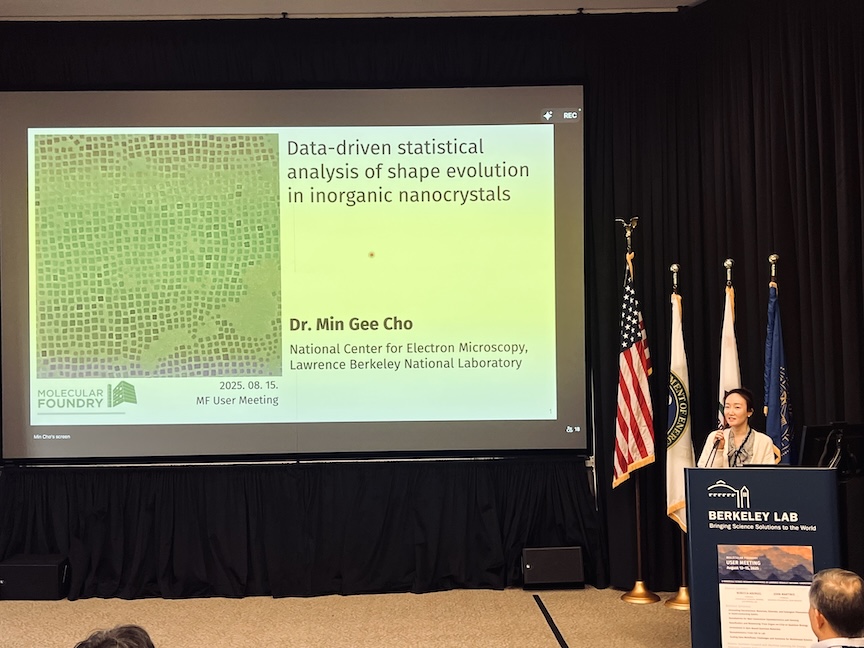
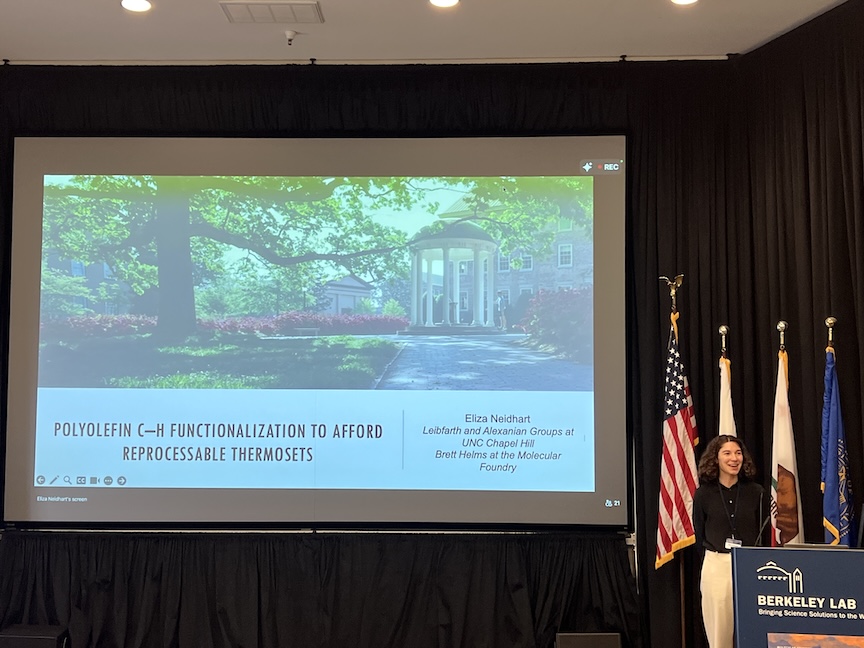
Poster Award Winners: Following an energetic poster SLAM and the evening poster reception on Thursday, the winners of the poster competition were: Bernard Field, Hudson Shih, and Casey Tran.

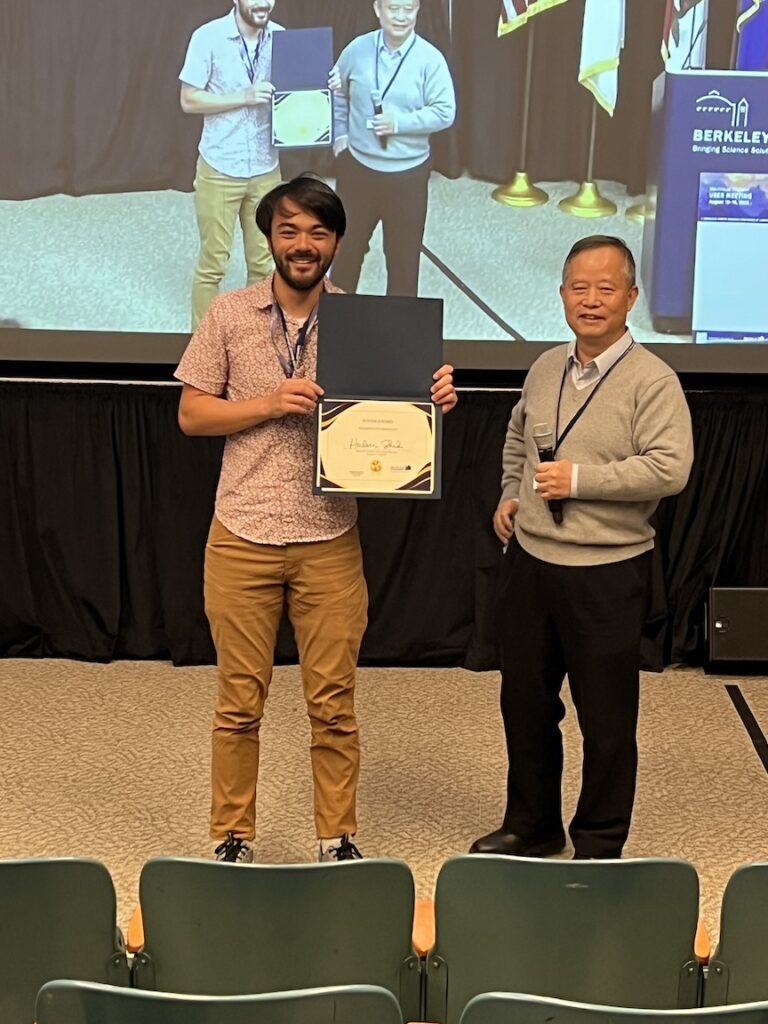
Outstanding Staff Service Award Winner: Ari Gashi from the Foundry’s Nanofabrication facility was awarded this year’s outstanding staff service award for his dedication to user service.
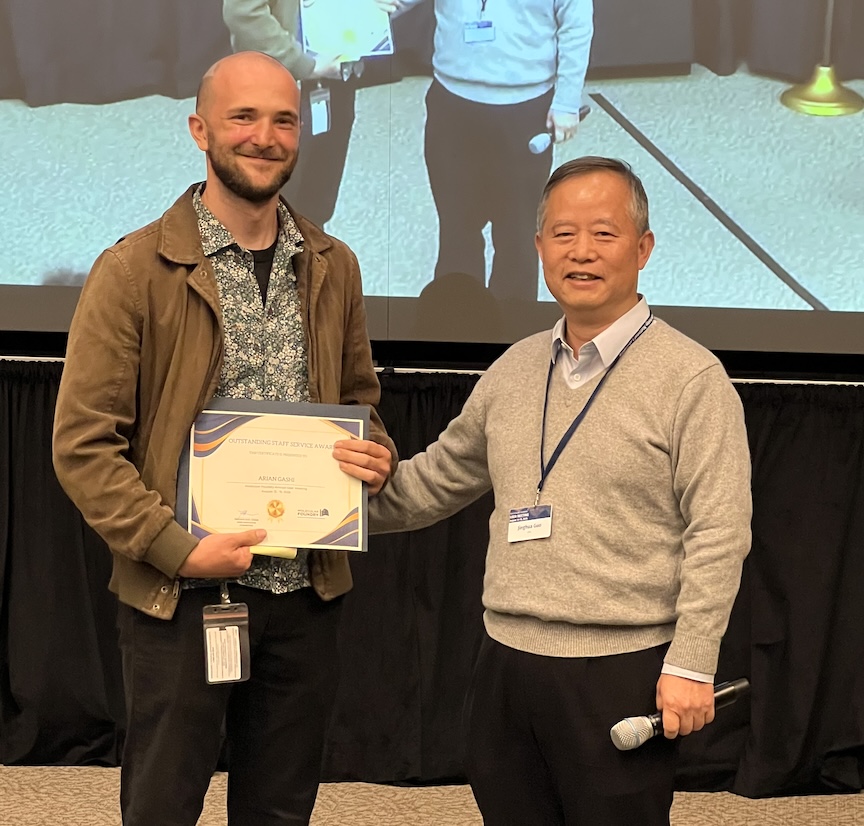
Research Symposia
The meeting’s program reflected the Molecular Foundry’s broad impact across multiple disciplines, with symposia covering:
- Halide perovskites and robotic workflows
- Machine learning-ready data preparation
- AI/ML-enabled materials development
- Spin-based quantum materials innovations
- Nanophotonics applications
- Nanofluidics and biosensing
- Decoherence in superconducting qubits
Nanofluidics and Biosensing from Organ-on-Chip to Quantum Biology: Noy (LLNL) and subsequently Li (LLNL) from the same laboratory introduced the formation of nanochannels form when two aqueous droplets covered with a lipid layer are brought into contact to form a droplet interface bilayer. With the application of a sufficiently high voltage (typically hundreds of millivolts) across the bilayer, nanochannels are formed by electroporation that enable the transport of ions from one droplet to the second droplet, leading to a current that is measurable with a much lower reding voltage. Upon removal of the higher voltage, the pores relax and vanish over a characteristic relaxation time, characterizing the plasticity of the system. The memristive behavior enable the storage of information by the accumulated charge in the initial droplet. By time sequencing the applied voltages they were able to demonstrate characteristics of a logic device, the basic building blocks for neuromorphic computing. Bedau (Western Digital) followed on the nanopore theme with the characterization of nanopores and nanochannels in the solid state. He discussed some of the constraints of current lithographic processes and materials and how these affect the expected readout signal. The low signal to noise ratio poses a major challenge in the use of these nanoscopic elements with multiple sources of noise and how they can be mitigated
being discussed.
Sampad (Fluxus, Inc.) rounded of the discussions on nanopores with an application as optofluidic biosensors that combine optical waveguides with microfluidic channels, that provide single-molecule sensitivity by optically counting individual biomolecules in flow. Solid-state nanopores, nanoscopic holes in an insulating substrate, have recently emerged as a low-cost sequencing and an ultrasensitive single molecule biosensor. An optical trap-assisted nanopore capture rate enhancement method was shown to yield up to a million-fold target concentration enhancement. By integrating molecular recognition processes with highly dispersive Fano resonances in opto-fluidic plasmonic sensors, Mutlu (UCSC) demonstrated an ultra-sensitive, label-free, and highly selective viral protein detection, achieving a limit-of-detection six orders of magnitude lower than the most sensitive diagnostic techniques. Kurian (Howard U) analyzed the cooperative effects induced by ultraviolet (UV) excitation of several biologically relevant tryptophan mega-networks, thus giving insight into novel mechanisms for cellular signaling and
control. Their theoretical analysis predicted the formation of strongly super-radiant states arising from collective interactions between organized arrangements of up to more than 100,000 tryptophan UV-excited transition dipoles in a microtubular architecture, leading to an experimentally confirmed enhancement of the fluorescence quantum yield in steady-state experiments.
Career Panel Discussion
This panel discussion, moderated by UEC member Andy Mannix (Stanford University) included perspectives from Matt Chipman (Gatan Ametek), Katie Inzani (University of Nottingham), Francois Leonard (Sandia National Laboratories), and Evgenii Vasilev (Limelight Steel). The panelists offered their experience on topics such as how to find the right job opportunity, and factors to consider as they launch their careers. A few pearls of wisdom included: Be open-minded about opportunities, especially those that may involve travel or relocation. Those who have an international training create connections that facilitate opportunities for research funding from a broader range of funding agencies. When mapping out career progression in 10-20 years, consider the day-to-day work of the roles and ask yourself if you will find joy and satisfaction in that work. We thank our panelists for sharing their time with our early career users!
Looking Forward
The 2025 Annual User Meeting underscored the Molecular Foundry’s critical role in advancing nanoscience research through world-class facilities, interdisciplinary collaboration, and innovative approaches to materials characterization and synthesis. With the integration of AI, automation, and advanced computational methods, the facility continues to enable groundbreaking research that addresses global challenges in energy, environment, healthcare, and fundamental science.
The meeting concluded with recognition of the collaborative spirit that drives scientific progress, highlighting how the combination of advanced instrumentation, computational resources, and diverse expertise continues to push the boundaries of what’s possible in nanoscience and materials research.

